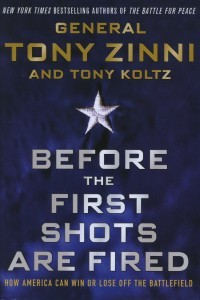 By General Tony Zinni and Tony Koltz, Palgrave MacMillan, New York, NY (2014)
By General Tony Zinni and Tony Koltz, Palgrave MacMillan, New York, NY (2014)
Reviewed by Nathan D. Wells
General Tony Zinni is one of the most respected senior officers alive today. A retired general in the United States Marine Corps and a former Commander in Chief of the United States Central Command (CENTCOM), Zinni brings over four decades of experience to the current state of American military actions and explains why the last half century has been underwhelming in a strategic sense. Drawing heavily from his penultimate posting at CENTCOM, as well as the parallel junior officer experiences of Zinni in Vietnam and his son in the current war on terror, a general feeling of déjà vu runs through this timely volume.
Recently retired before the attacks on 9/11, Zinni was one of the most vocal senior officers apprehensive over the Bush administration seemingly rushing headlong into war. While the events that led to the military conflicts in Afghanistan and Iraq are the central events of the book, the central theme relates the America’s foreign policy strategy, or lack thereof. The United States embraced Presidential Doctrines from James Monroe to the present, but the last half-century has seen often underwhelming results. This was in spite of the fact that the National Security Act of 1947, in addition to reorganizing the Armed Forces under the single umbrella of the Department of Defense, requires the administration to enact an overriding national strategy, the National Security Strategy. The NSS is further broken down into the National Defense Strategy (on military and nonmilitary requirements for security) and the National Military Strategy (for military-specific guidance). A President must present an NSS to Congress within 150 days of taking office. In reality, most administrations since Eisenhower have made do with jury-rigged pseudo-strategies and a focus on combating what Zinni calls the “isms” of the day.
One of the unfortunate side effects of being a wealthy, powerful nation is that much strategic thinking and foreign policymaking in regards to military affairs is overly focused on technology and “bean counting.” Robert McNamara’s obsession with numbers was beneficial to the Defense Department as a whole, as spending could be better tracked, but the focus on body counts in Vietnam did nothing for the American military effort in Vietnam, as Zinni saw as an advisor and company grade officer there. Since the all-volunteer military began in 1973, this problem has become all the more acute. While being a superpower means that there is potentially more muscle to throw around, being an open, enlightened democracy complicates things. Not only are administrations under constant scrutiny, so are senior military and political officials. The high turnover rate among generals and cabinet officials in the last decade is stark illustration of this. This in turn trickles down to those on the ground. As a National Guard soldier put it to Zinni while on a tour of the Afghan-Pakistani border, instead of a decade long war, “it’s been ten one-year wars.”[i]
Whoever has the President’s ear is a powerful individual or group of individuals. While the National Security Act of 1947 established the National Security Council (and the later National Security Agency) to advise the President on such matters, his opinion and those of those closest to him can often be more important. In regards to President George W. Bush, the belief was that instead of taking cues from his NSC or the NSA, Bush along with Vice President Dick Cheney and Secretary of Defense Donald Rumsfeld made the decision to initiate hostilities and focus on Iraq over Afghanistan. Zinni takes particular affront to those hawkish neocons that ignored several high-level war-game scenarios that illustrated the complex problems (not to mention high troop levels and dollar amounts) required to garrison the area. While there is a fog of war, chalking up any major setback to operations (the famous “unknown unknowns” Rumsfeld spoke of in a 2002 speech) to this in spite of being advised of said potential problems by experienced goes to the very heart of a lack of strategic vision.[ii]
The overriding question throughout the book (as well as the title of its first chapter) is, “How the Hell Did We Get Here?” That the question needs to be asked is a troubling one for a superpower that should have a cohesive strategy. That the question may be difficult to answer is an even more troubling. The necessity of an administration to have a workable National Security Strategy at the outset and being able to define how much of the “world’s policeman” the United States will seek to be on its watch are necessities of the very highest order. As someone whose career went from being a boot on the ground to the upper echelons of power, General Zinni knew this quite well.
This is an important volume and should find a spot on the bookshelf of anyone interested in military or political affairs.
Nathan D. Wells is an adjunct instructor of History at Quincy College in Quincy, MA.
[i] Zinni, Tony and Tony Koltz, Before the First Shots are Fired: How America Can Win or Lose Off the Battlefield Palgrave MacMillan (2014) P. 15
[ii] Ibid, p. 41.

